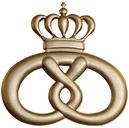
What Did the Vikings Eat?
Tuesday, January 11, 2022
Vikings ate hearty meals with meat, dairy, grains, fruit and vegetables to maintain their energy, since their everyday activities included exploring unknown lands and sailing the open waters. In fact, during the Middle Ages, even a poor Viking had a diet that was considerably better than that of an English peasant. The Vikings often ate what they could grow on farms, hunt, or gather, giving them a well-balanced diet to supplement their active lifestyle.
Viking Diet Food Groups

Meat & Fish
Since many Scandinavians lived on the coast, various types of fish such as herring, salmon and trout were a regular addition to Viking meals. Almost everyone in the Viking community from kings to common sailors ate meat every day which is why they raised animals such as cows, sheep, goats, chickens, ducks and horses on their farms. Pork was also a popular meat choice as pigs were easy to raise and matured quickly. As avid hunters, Vikings would also capture reindeer, elk and bear to eat. These ingredients are still popular today with smørrebrød, or famous Danish open faced sandwiches, best served with Danish grain breads.
While you may think that a fire pit was the method of choice for cooking meat, Vikings preferred to boil their food. When the meat and vegetables were cooked and taken out of the pot, they would add fresh trimmings to the meat stew, called skause, making it more concentrated. Every year, our family at O&H Danish Bakery still attempts to visit the local Danish brotherhood in Kenosha, Wisconsin and participate in the Torsk dinner. A delicious Viking dinner, Torsk refers to a broiled and buttered cod fillet with a side of boiled potatoes and, in this case, a mustard gravy. It’s usually served with a shot of aquavit, a fiery distilled spirit that often has a distinct caraway flavoring.
Fruits & Vegetables

Grains
Most Viking meals included basic flatbread made from a variety of different crops that they grew. The Northern climate was excellent for growing barley, rye and oats so these grains were a staple in the Norse diet. While farmers would sow seed in the spring and harvest their crop in the late summer or fall, Vikings would also forage for grain such as bark-birch, which was very nutritious when dried and ground.
Dairy
If a cow wasn’t used for its meat, then it was most likely a very good producer of milk. The Vikings would drink milk, whey, buttermilk or use the dairy product to make cheese, butter, and curds to eat.
Drinks
Vikings are well known for drinking copious amounts of ale every day, although the type of beer they drank had a relatively low alcohol content. They also took beer on their Viking ships as the fermentation and brewing process meant their drink stayed fresh longer than water. Mead and imported wines were more of a special occasion drink that was saved and consumed at feasts.
Typical Viking Meals
A Viking family would typically eat two meals per day. Dagmal was the morning meal in which the adults would eat leftover stew from the night before with bread and fruit. The children would usually have porridge and dried fruit or, on occasion, buttermilk and bread. A Viking dinner or evening meal was called Nattmal, which they would have at the end of their working day. This meal consisted of meat with stewed vegetables accompanied by an ale drink.
Viking Feasts

Get Viking-Inspired Foods from O&H Danish Bakery Delivered Straight to Your Door
Just as Vikings traveled the seas in search of new land, we scour the world hunting out the finest ingredients to add to our extensive selection of Scandinavian pastries. So whether you want to eat like a Viking or eat as much as a Viking, we’ll always have your bakery and dessert covered. You can easily order our mouthwatering treats online and enjoy the convenience of having them delivered to your door! Reach out to our friendly staff with any questions.




